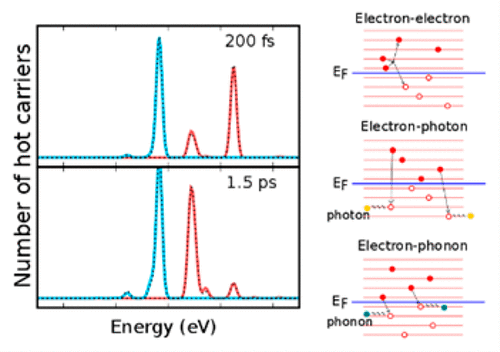当前位置:
X-MOL 学术
›
ACS Photonics
›
论文详情
Our official English website, www.x-mol.net, welcomes your feedback! (Note: you will need to create a separate account there.)
Relaxation of Plasmon-Induced Hot Carriers
ACS Photonics ( IF 7 ) Pub Date : 2017-12-08 00:00:00 , DOI: 10.1021/acsphotonics.7b00881 Jun G. Liu , Hui Zhang , Stephan Link , Peter Nordlander
ACS Photonics ( IF 7 ) Pub Date : 2017-12-08 00:00:00 , DOI: 10.1021/acsphotonics.7b00881 Jun G. Liu , Hui Zhang , Stephan Link , Peter Nordlander

|
Plasmon-induced hot carrier generation has attracted much recent attention due to its promising potential in photocatalysis and other light harvesting applications. Here we develop a theoretical model for hot carrier relaxation in metallic nanoparticles using a fully quantum mechanical jellium model. Following pulsed illumination, nonradiative plasmon decay results in a highly nonthermal distribution of hot electrons and holes. Using coupled master equations, we calculate the time-dependent evolution of this carrier distribution in the presence of electron–electron, electron–photon, and electron–phonon scattering. Electron–electron relaxation is shown to be the dominant scattering mechanism and results in efficient carrier multiplication where the energy of the initial hot electron–hole pair is transferred to other multiple electron–hole pair excitations of lower energies. During this relaxation, a small but finite fraction of electrons scatter into luminescent states where they can recombine radiatively with holes by emission of photons. The energy of the emitted photons is found to follow the energies of the electrons and thus redshifts monotonically during the relaxation process. When the energies of the electrons approach the Fermi level, electron–phonon interaction becomes dominant and results in heating of the nanoparticle. We generalize the model to continuous-wave excitation and show how nonlinear effects become important when the illumination intensity increases. When the temporal spacing between incident photons is shorter than the relaxation time of the hot carriers, we predict that the photoluminescence will blueshift with increasing illumination power. Finally, we discuss the effect of the photonic density of states (Purcell factor) on the luminescence spectra.
中文翻译:

等离子体诱导的热载体的弛豫
等离子体诱导的热载流子产生由于其在光催化和其他光收集应用中的潜在潜力而引起了近期的关注。在这里,我们使用完全量子力学的凝胶模型为金属纳米颗粒中的热载流子弛豫建立了理论模型。在脉冲照明之后,非辐射等离子体激元衰减导致热电子和空穴高度非热分布。使用耦合主方程,我们计算在电子-电子,电子-光子和电子-声子散射的存在下,这种载流子分布随时间的变化。电子-电子弛豫被证明是主要的散射机制,并导致有效的载流子倍增,其中最初的热电子-空穴对的能量转移到了其他低能的多个电子-空穴对的激发。在这种弛豫过程中,一小部分有限的电子会散射为发光态,在这些状态下,它们可以通过发射光子与空穴进行辐射复合。发现发射的光子的能量跟随电子的能量,因此在弛豫过程中单调地红移。当电子的能量接近费米能级时,电子与声子的相互作用就占主导地位,并导致纳米粒子发热。我们将模型推广到连续波激励,并说明当光照强度增加时,非线性效应如何变得很重要。当入射光子之间的时间间隔短于热载流子的弛豫时间时,我们预测光致发光将随着照明功率的增加而蓝移。最后,我们讨论了光子状态密度(赛尔因子)对发光光谱的影响。
更新日期:2017-12-08
中文翻译:

等离子体诱导的热载体的弛豫
等离子体诱导的热载流子产生由于其在光催化和其他光收集应用中的潜在潜力而引起了近期的关注。在这里,我们使用完全量子力学的凝胶模型为金属纳米颗粒中的热载流子弛豫建立了理论模型。在脉冲照明之后,非辐射等离子体激元衰减导致热电子和空穴高度非热分布。使用耦合主方程,我们计算在电子-电子,电子-光子和电子-声子散射的存在下,这种载流子分布随时间的变化。电子-电子弛豫被证明是主要的散射机制,并导致有效的载流子倍增,其中最初的热电子-空穴对的能量转移到了其他低能的多个电子-空穴对的激发。在这种弛豫过程中,一小部分有限的电子会散射为发光态,在这些状态下,它们可以通过发射光子与空穴进行辐射复合。发现发射的光子的能量跟随电子的能量,因此在弛豫过程中单调地红移。当电子的能量接近费米能级时,电子与声子的相互作用就占主导地位,并导致纳米粒子发热。我们将模型推广到连续波激励,并说明当光照强度增加时,非线性效应如何变得很重要。当入射光子之间的时间间隔短于热载流子的弛豫时间时,我们预测光致发光将随着照明功率的增加而蓝移。最后,我们讨论了光子状态密度(赛尔因子)对发光光谱的影响。


























 京公网安备 11010802027423号
京公网安备 11010802027423号